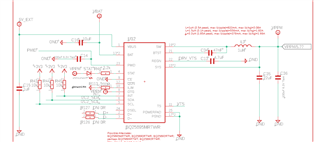On a custom board, I'd like to get about 1.5A charge current out of this BQ25895MRTWR. However, I'm only getting around 500mA. Below is a snapshot of the registers along with my comments.
It appears that the chip is getting into DPM mode due to IINDPM. However, I have a fixed 5V supply feeding the chip (not USB), whose value is confirmed by Reg11 (and measured at chip pins as 4.987V). This should be well above the FORCE_VINDPM absolute VINDPM threshold of 3.9V. Meanwhile, IINLIM and IDPM_LIN are both set at 1.5A. So why am I only getting 600mA.
Note as well that the incoming 5V supply feeds both this charger and another load of about 800mA. But the 5V is not falling below 3.9V. It's holding well. Nevertheless, when I decrease the 800mA load, the charge current rises to about 750mA. This makes no sense. First, it's still not 1.5A. Second, the incoming 5V on VBUS looks good at 5V, never 3.9V. (On the scope, that power looks good, with the worst glitch being a ring down as low as 4.6V lasting about 300ns for 3 dips in the ringing. This still remains well above 3.9V and is very fast.)
I note also that VBUS_STAT is 0b111 for OTG. Perhaps the chip figures OTG because of the 5V incoming supply. Datasheet Table 3 mentions IINLIMs per VBUS_STAT, but 111 (OTG) isn't listed. I have D+/D- detection disabled anyway.
Here are my notes. Hopefully you can click on them to enlarge and make legible. The small size I see below was the default for drag and drop into the forum. I attached a pdf version of the same, just in case...



